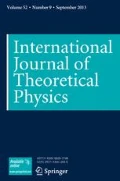Abstract
Recent works have independently suggested that quantum mechanics might permit procedures that fundamentally transcend the power of Turing Machines as well as of ‘standard’ Quantum Computers. These approaches rely on and indicate that quantum mechanics seems to support some infinite variant of classical parallel computing.
We compare this new one with other attempts towards hypercomputation by separating (1) its %principal computing capabilities from (2) realizability issues. The first are shown to coincide with recursive enumerability; the second are considered in analogy to ‘existence’ in mathematical logic.
Similar content being viewed by others
REFERENCES
Adamyan, V. A., Calude, C. S., and Pavlov, B. S. (2004). Transcending the limits of Turing computability. T. Hida, K. Saito, S. Si, (ed), Quantum Information Complexity. Proceedings of Meijo Winter School 2003, World Scientific, Singapore,pp. 119–137. %!http://arXiv.org/quant-ph/ 0304128!
Atallah, M. J. (ed.) (1999). Algorithms and Theory of Computation Handbook, CRC Press, Boca Raton, Florida.
Berlekamp, E. R., Conway, J. H., and Guy, R. K. (2004). Winning Ways for Your Mathematical Plays, vol. 4, 2nd Edn., Academic Press, New York.
Beggs, E. J. and Tucker, J. V. (2004). Computations via Experiments with Kinematic Systems, Technical Report 5–2004, Department of Computer Science, University of Wales Swansea.
Benioff, P. (1980). The computer as a physical system: A microscopic quantum mechanical Hamiltonian model of computers as represented by Turing Machines. Journal of Statistical Physics 22, 563– 591.
Bennett, C. H. and Landauer, R. (1985). The fundamental physical limits of computation. Scientific American 253(1), 48–56.
Blass, A. (1984). Existence of bases implies the axiom of choice. Axiomatic Set Theory, Contemporary Mathematics 31, 31–33.
Blum, L., Shub, M., and Smale, S. (1989). On a theory of computation and complexity over the real numbers: NP-completeness, recursive functions, and universal machines. Bulletin of the American Mathematical Society 21, 1–46.
Burgin, M. and Klinger, A. (eds.) (2004). Super-recursive algorithms and hypercomputation. vol. 317. In Theoretical Computer Science, Elsevier, Amsterdam.
Calude, C. S., Dinneen, M. J., and Svozil, K. (2001). Reflections on quantum computing. In Complexity, Vol. 6(1), Wiley, New York.
Calude, C. S., Dinneen, M. J., and Peper, F. (eds.) (2002). Unconventional Models of Computation, Vol. 2509. In Lecture Notes in Computer Science, Springer, Heidelberg.
Calude, C. S. and Pavlov, B. (2002). Coins, quantum measurements, and Turing's barrier. In Quantum Information Processing, Vol. 1, Plenum, New York, pp. 107–127.
Copeland, J. (1997). The broad conception of computation. American Behavioural Scientist 40, 690–716.
Copeland, J. (2002). Hypercomputation. Minds and Machines 12, 461–502.
Copeland, J. and Proudfoot, D. (1999). Alan Turing's forgotten ideas in computer science. Scientific American 280(4), 98–103.
Du, D.-Z. and Ker-I Ko (2000). Theory of Computational Complexity, Wiley, New York.
Eberbach, E. and Wegner, P. (2003). Beyond Turing Machines. Bulletin of the European Association for Theoretical Computer Science 81, 279–304.
van Emde Boas, P., Spaan, E., and Torenvliet, L. (1989). Nondeterminism, fairness and a fundamental analogy. The Bulletin of the European Association for Theoretical Computer Science 37, 186– 193.
Etesi, G. and Németi, I. (2002). Non-Turing computations via Malament–Hogarth Space–Times. International Journal of Theoretical Physics 41(2), 341–370.
M. Fürer: “The tight deterministic time hierarchy”, % pp.8-16 in Proc. 14th ACM Symposium on Theory of Computing % (1982).
Geroch, R. and Hartle, J. B. (1986). Computability and physical theories. Foundations of Physics 16(6), 533–550.
del, K. (1940). The Consistency of the Axiom of Choice and of the Generalized Continuum-Hypothesis With the Axioms of Set Theory, Princeton University Press, Princeton.
Gruska, J. (1999). Quantum Computing, McGraw-Hill, New York.
Hamkins, J. D. and Lewis, A. (2000). Infinite time Turing machines. Journal of Symbolic Logic 65(2), 567–604.
Hogarth, M. L. (1992). Does general relativity allow an observer to view an eternity in a finite time?. Foundations of Physics Letters 5(2), 173–181.
Hopcroft, J. E., Motwani, R., and Ullman, J. D. (2001). Introduction to Automata Theory, Languages, and Computation, Addison-Wesley, Reading, MA.
Kieu, T. (2003). Computing the non-computable. Contemporary Physics 44(1), 51–71.
Kieu, T. (2003). Quantum algorithm for Hilbert's Tenth Problem. International Journal of Theoretical Physics 42, 1461–1478.
Matiyasevich, Y. V. (1970). Enumerable sets are diophantine. Soviet Mathematics. Doklady 11, 354–357.
Ord, T. (2002). Hypercomputation: Computing more than the Turing machine, Honours Thesis, University of Melbourne, Melbourne; available from \verb!http://arXiv.org/math.LO/0209332.!
Odifreddi, P. (1989). Classical Recursion Theory, North-Holland, Amsterdam.
Shagrir, O. and Pitowsky, I. (2003). Physical hypercomputation and the Church–Turing Hypothesis. Minds and Machines 13, 87–101.
Soare, R. I. (1987). Recursively Enumerable Sets and Degrees, Springer, Heidelberg.
Turing, A. M. (1936). On computable numbers, with an application to the Entscheidungsproblem. Proceedings of the London Mathematical Society 42(2), 230–265.
Turing, A. M. (1939). Systems of logic based on ordinals. Proceedings of the London Mathematical Society 45, 161–228. %
Yao, A. C.-C. (2003). Classical physics and the Church–Turing Thesis. Journal of the Association for Computing Machinery 50(1), 100–105.
Author information
Authors and Affiliations
Corresponding author
Additional information
PACS (2003): 03.67.
Supported by DFG project Zi1009/1-1.
Rights and permissions
About this article
Cite this article
Ziegler, M. Computational Power of Infinite Quantum Parallelism. Int J Theor Phys 44, 2059–2071 (2005). https://doi.org/10.1007/s10773-005-8984-0
Received:
Accepted:
Issue Date:
DOI: https://doi.org/10.1007/s10773-005-8984-0




